Child Trafficking
Sex trafficking – children under the age of 18 induced to participate in commercial sex (Child Welfare, 2015).
Labor trafficking – fraudulent and coercive actions targeted at subjecting individuals to involuntary servitude, debt bondage, or slavery (Child Welfare, 2015).
In 2011 – FBI estimated 293,000 young people at risk of trafficking in North America, alone (Child Welfare, 2015).
In 2013 – 1 in 7 “endangered” underage runaways was likely to become a victim of sex trafficking; in 2014 – 1 in 6 (Child Welfare, 2015).
Child trafficking is a global issue differentiated into the following types:
- Sex trafficking, which refers to children under the age of 18 induced to participate in commercial sex (Child Welfare, 2015).
- Andlabor trafficking, defined as fraudulent and coercive actions targeted at subjecting individuals to involuntary servitude, debt bondage, or slavery (Child Welfare, 2015).
With regards to statistics, in 2011 the FBI estimated that there were 293,000 young people at risk of trafficking in North America, alone (Child Welfare, 2015).
In 2013, it was found that 1 in 7 “endangered” underage runaways was likely to become a victim of sex trafficking; in 2014 the estimation changed to 1 in 6 children (Child Welfare, 2015).
- Young people and children that live in “out-of-home care” – higher risk of becoming subjects of trafficking.
- Children that lack care due to their vulnerability are targets (Menzel, 2013).
- Lack emotional support – traffickers promise to provide that support via different incentives (Child Welfare, 2015).
- Violence is used to control children and exploit them.
- 50-90% involved in Child Welfare services were victims of sex trafficking (Child Welfare, 2015).
Young people and children that live in “out-of-home care” due to reasons of abuse or lack of resources are at higher risk of becoming subjects of trafficking. Traffickers usually target children that lack care due to their vulnerability (Menzel, 2013). Because children lack emotional support, traffickers promise to provide that support via monetary incentives or psychological manipulations (Child Welfare, 2015). Moreover, traffickers use violence to control children and exploit them. An astonishing statistic showed that 50-90% of children involved in Child Welfare services were victims of sex trafficking (Child Welfare, 2015).
Sex trafficking of minors presents a significant challenge for the U.S. Child Welfare because 300,000 underage girls (with the typical age of 12-14) are being sold for sex every year in the U.S. Moreover, it was found that a trafficked minor is sold for sex 15 times a day.

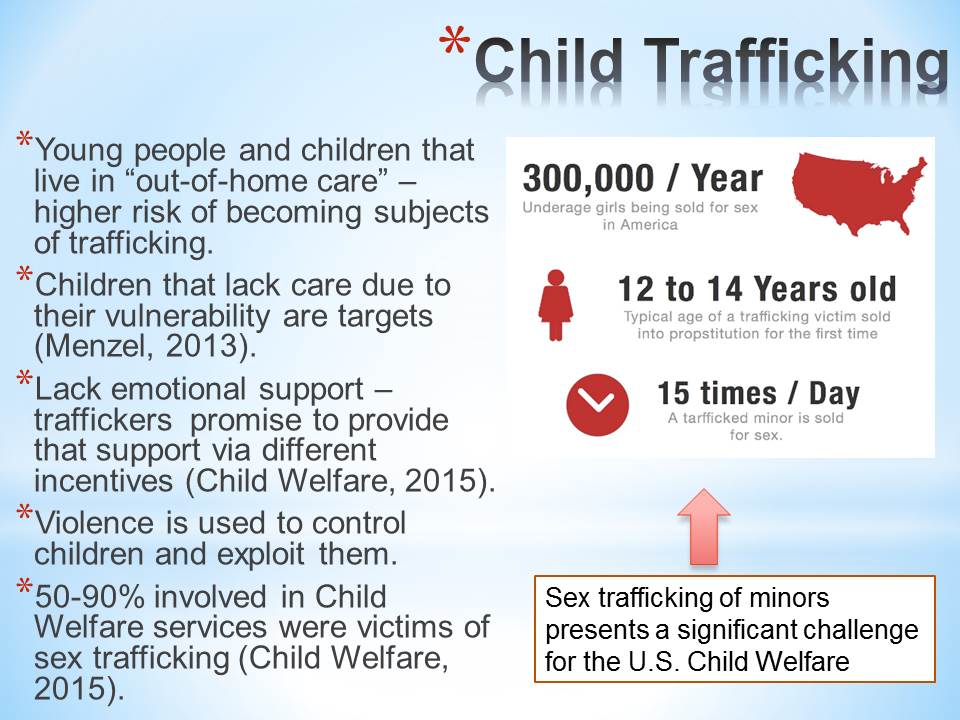
Consequences
Long-term
Physical health problems (HIV/AIDS)
Lasting psychological challenges:
- lack of confidence;
- depression;
- anxiety;
- low self-esteem;
- flashbacks;
- relationships with other people. (Rafferty, 2008).
Short-term
Physical health problems:
- unwanted pregnancies;
- treatable diseases.
Educational deprivation:
- developmental delays;
- poor academic performance;
- deficit in memory and verbal skills.
Behavioral outcomes
- lack of trust in adults;
- antisocial behavior;
- attachment difficulties;
- issues with relating to others.
With regards to the consequences of child trafficking, they are differentiated into short- and long-term
Long-term consequences include:
Physical health problems (HIV/AIDS and other health issues).
Lasting psychological challenges, such as lack of confidence, depression, anxiety, low self-esteem, flashbacks, relationships with other people (Rafferty, 2008).
Short-term consequences include physical health problems such as unwanted pregnancies, abortions, and treatable diseases. Educational deprivation is another implication of child trafficking. It includes developmental delays, poor academic performance, the deficit in memory and verbal skills.
Behavioral outcomes can be classified as either long- or short-term depending on the severity of an impact on the child. Such consequences include lack of trust in adults, antisocial behavior, attachment difficulties, and issues with relating to others.
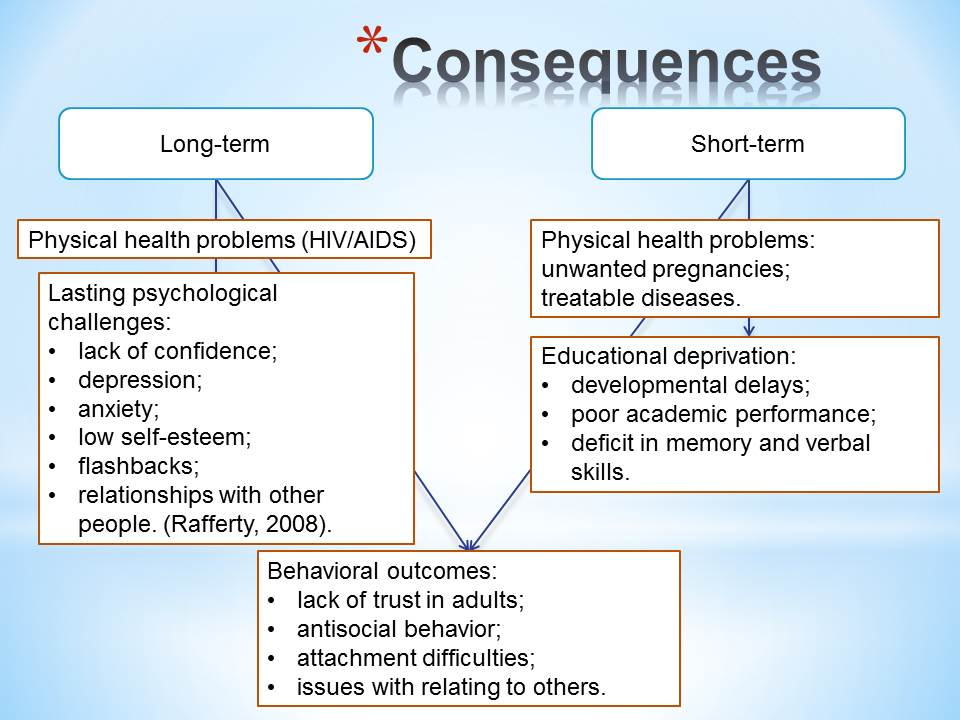
Cultural, Gender, and Class Issues
High family risk factors – risk of child taken away:
- poverty;
- ethnic minorities;
- marginalized social groups.
Victims are disproportionately female (Rafferty, 2008):
- discrimination against women;
- lack of social policy protection;
- patriarchal structures.
Underdeveloped cultures:
- kidnapping children for forced labor (slavery);
- kidnapping children for forced marriage (Chung, 2009).
Child trafficking is associated with numerous gender, cultural, and class issues.
With regards to class issues, there is a risk of a child being taken away if the family shows high-risk factors such as poverty, belonging to ethnic minorities or marginalized social groups.
The main gender issue in relation to child trafficking is that victims are disproportionately female (Rafferty, 2008) because of the discrimination against women, lack of social policy protection, and the presence of patriarchal structures. Cultural issues are associated with the lack of cultural regulations that prevent children from being trafficked. Thus, children are often kidnapped for slavery or forced marriage (Chung, 2009).
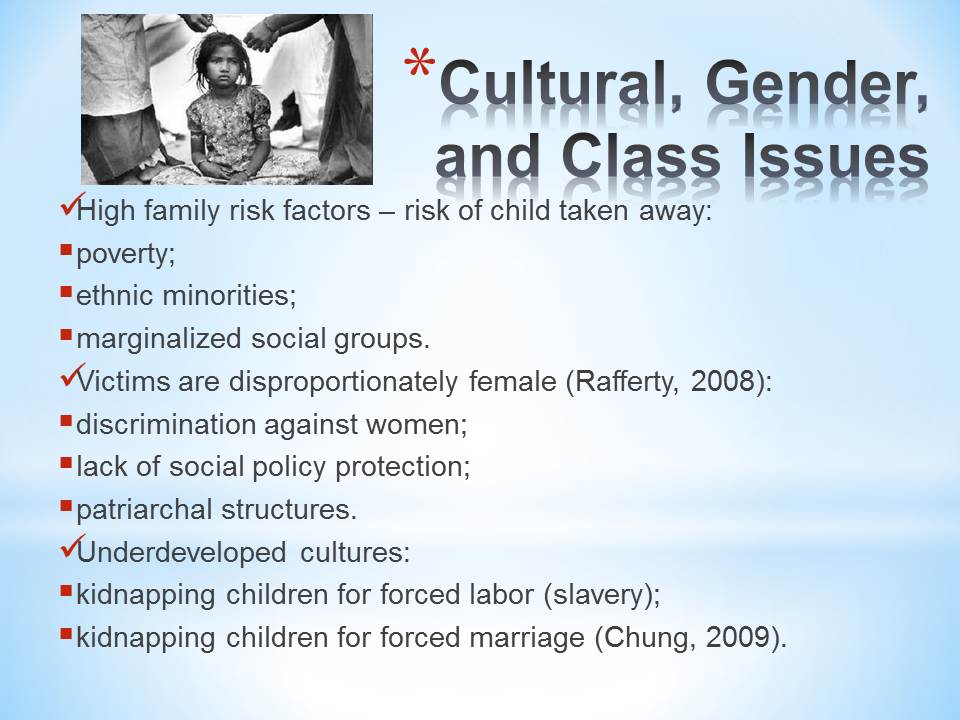
Ethical Dilemmas
Trafficking for organs:
Victim comes from one country, the recipient comes from another, and the transplant surgery takes place in yet another jurisdiction while medics are also from different countries (OSCE, 2014);
- Inability to acquire consent for research (Siegel & de Wildt, 2016);
- Researchers break rules to expose exploiters;
- Predators find vulnerable victims on social networking;
- Trafficked individuals are treated as illegal aliens;
- Global system of goods movement without such a system for movement of people.
Child trafficking presents the global community with many ethical dilemmas.
For example, there are difficulties in dealing with trafficking for organs because in many cases a victim comes from one country, the recipient comes from another, and the transplant surgery takes place in yet another jurisdiction, while medics are also from different countries (OSCE, 2014).
Moreover, due to the peculiarities of child trafficking, it is often impossible to acquire consent for research (Siegel & de Wildt, 2016), so researchers break rules to expose exploiters.
Social networking presents another dilemma since predators use it to find young and vulnerable victims. Lastly, while there is a global system of goods movement, there is no such system for the movement of people, which causes many governments to treat trafficked individuals as illegal aliens.
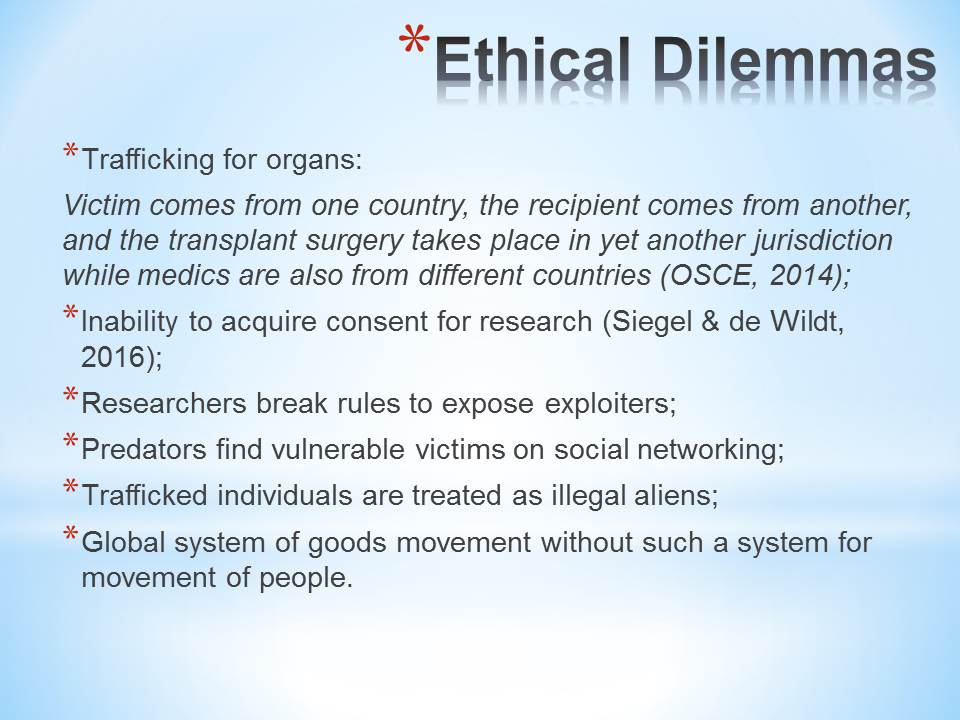
Solutions
Macro
- Establishment of UN-governed control over illegal movements of children;
- Reaffirmation of worldwide standards for child protection services;
- Provision of help to those countries that lack governmental resources to deal with child trafficking.
Mezzo
- Raising awareness of the issue in regions where child trafficking is common;
- Collaboration between governments, child protection services (e.g. Child Welfare) and communities for better control efforts;
- Educating communities about the severe implications of child trafficking.
Micro
- Support efforts targeted at protecting families at risk of having children taken away;
- Monitoring marginalized members of the community;
- Researching child trafficking insights on the basis of real-life examples of children.
Lastly, it is important to mention possible solutions to child trafficking that can be implemented on macro, mezzo, and micro levels.
On the macro level, it is proposed to:
- Establish UN-governed control over illegal movements of children;
- Reaffirm worldwide standards for child protection services;
- Provide help to those countries that lack governmental resources to deal with child trafficking.
- On the mezzo level, it is proposed to:
- Raise awareness of the issue in regions where child trafficking is common;
- Governments, child protection services (e.g. Child Welfare) and communities should collaborate for better control efforts;
- Educate communities about the severe implications of child trafficking.
- On the micro level, the following solutions are offered:
- Support efforts targeted at protecting families at risk of having children taken away;
- Monitoring marginalized members of the community;
- Researching child trafficking insights on the basis of real-life examples of trafficked children.
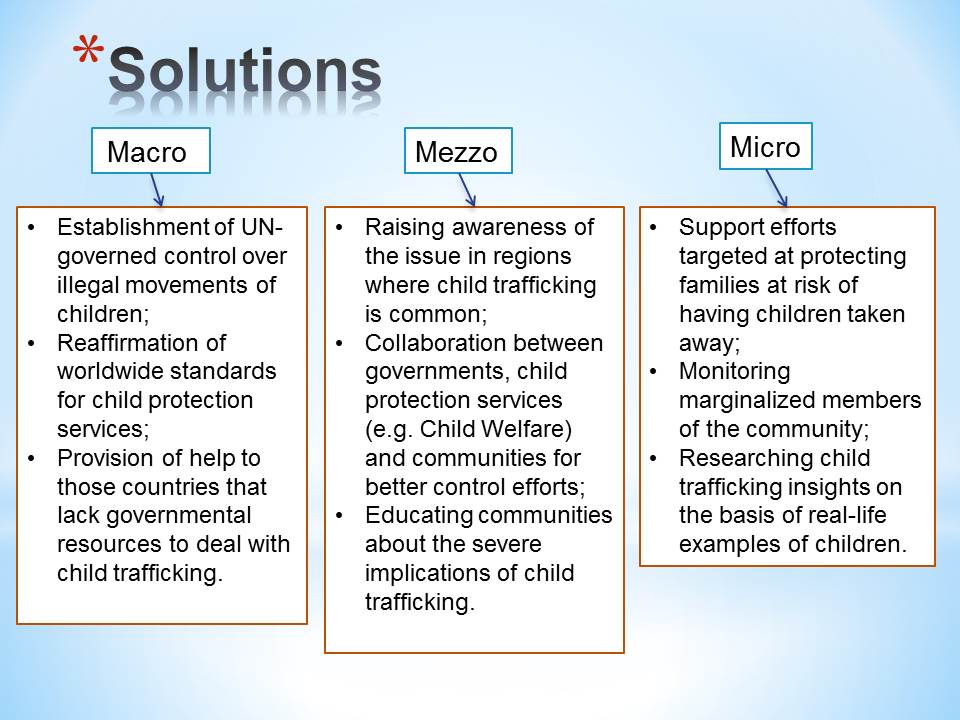
References
Child Welfare. (2015). Child Welfare and human trafficking. Web.
Chung, R. (2009). Cultural perspectives on child trafficking, human rights & social justice: A model for psychologists. Related Reports on Models of Human Rights and Mental Health, 22(1), 1-11.
Menzel, M. (2013). Foster care sex trafficking: Pimps, labor contractors targeting youth in Florida foster care system. Web.
OSCE. (2014). Do the right thing: Ethical issues and the fight against human trafficking. Web.
Rafferty, Y. (2008). The impact of trafficking on children: Psychological and social policy perspectives. Child Development Perspectives, 2(1), 13-18.
Siegel, D., & de Wildt, R. (2016). Ethical concerns in research on human trafficking. New York, NY: Springer.